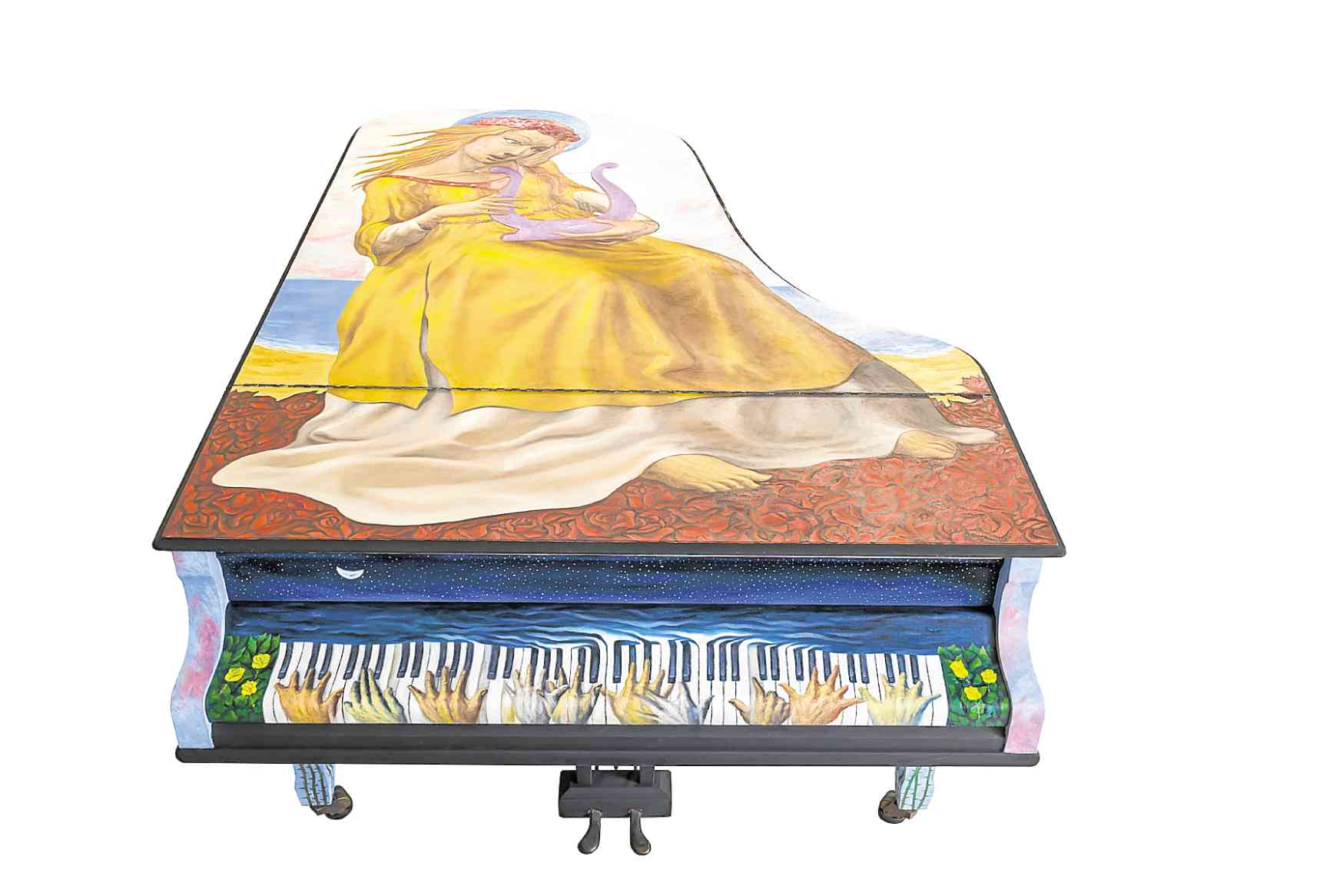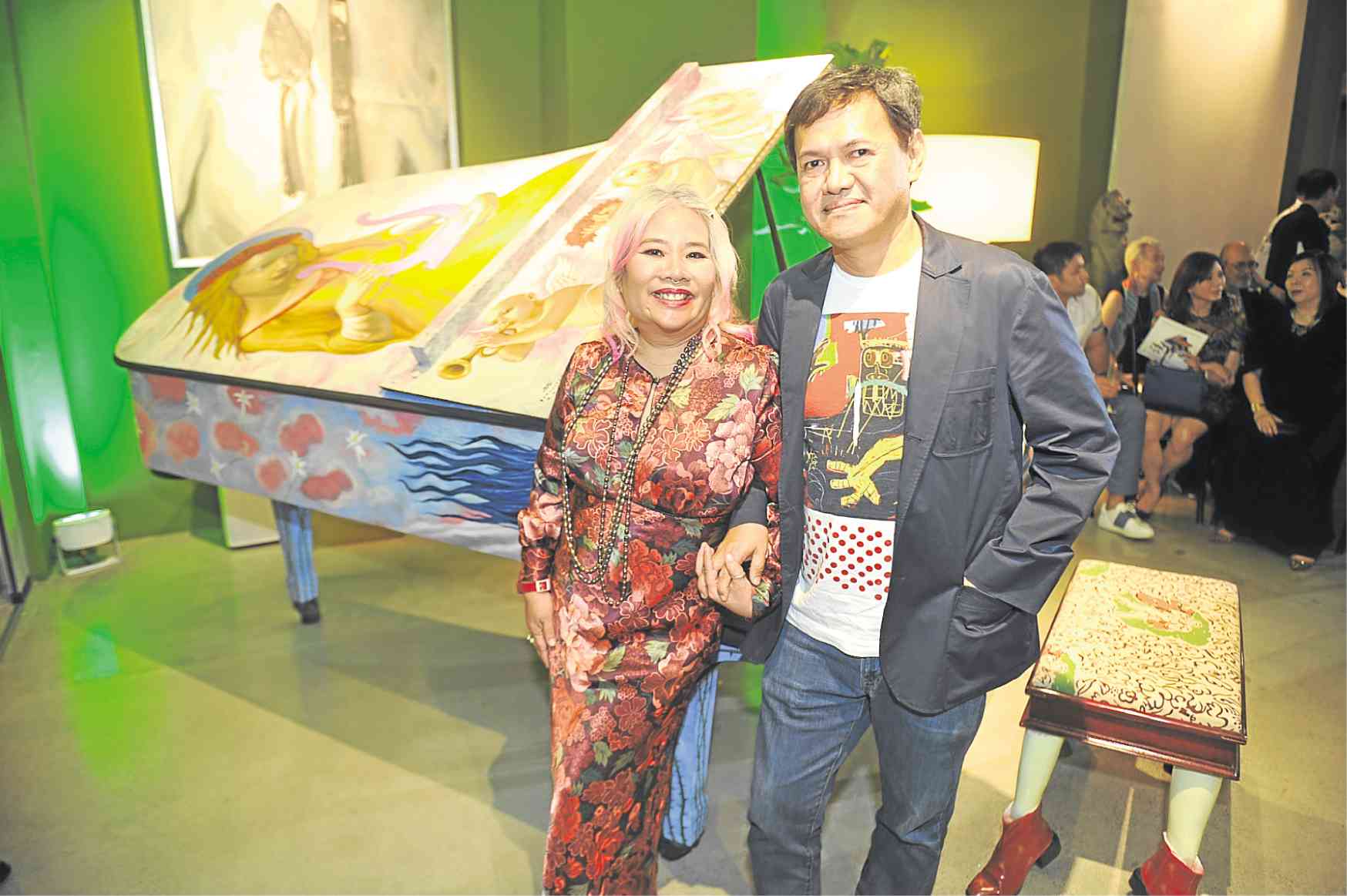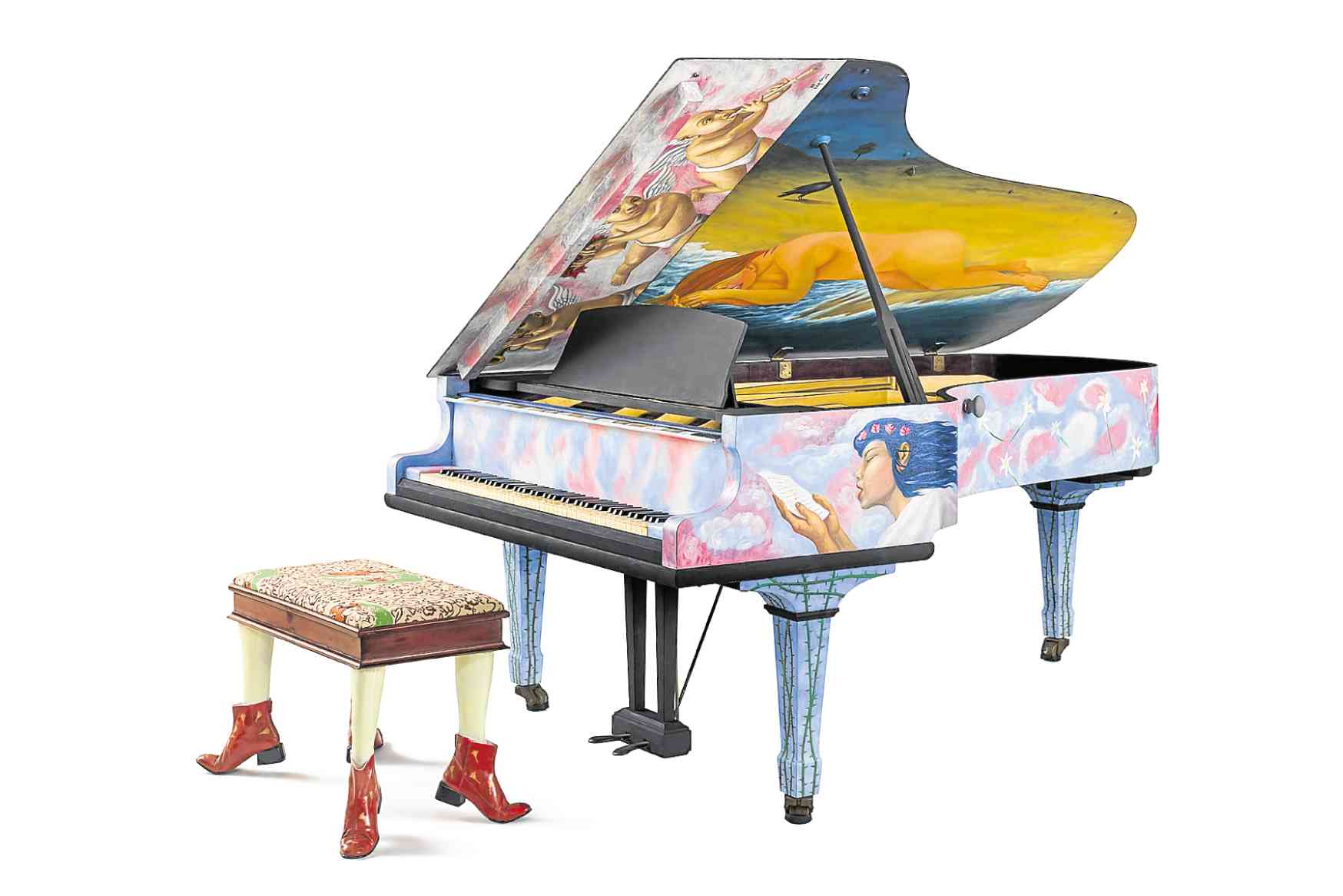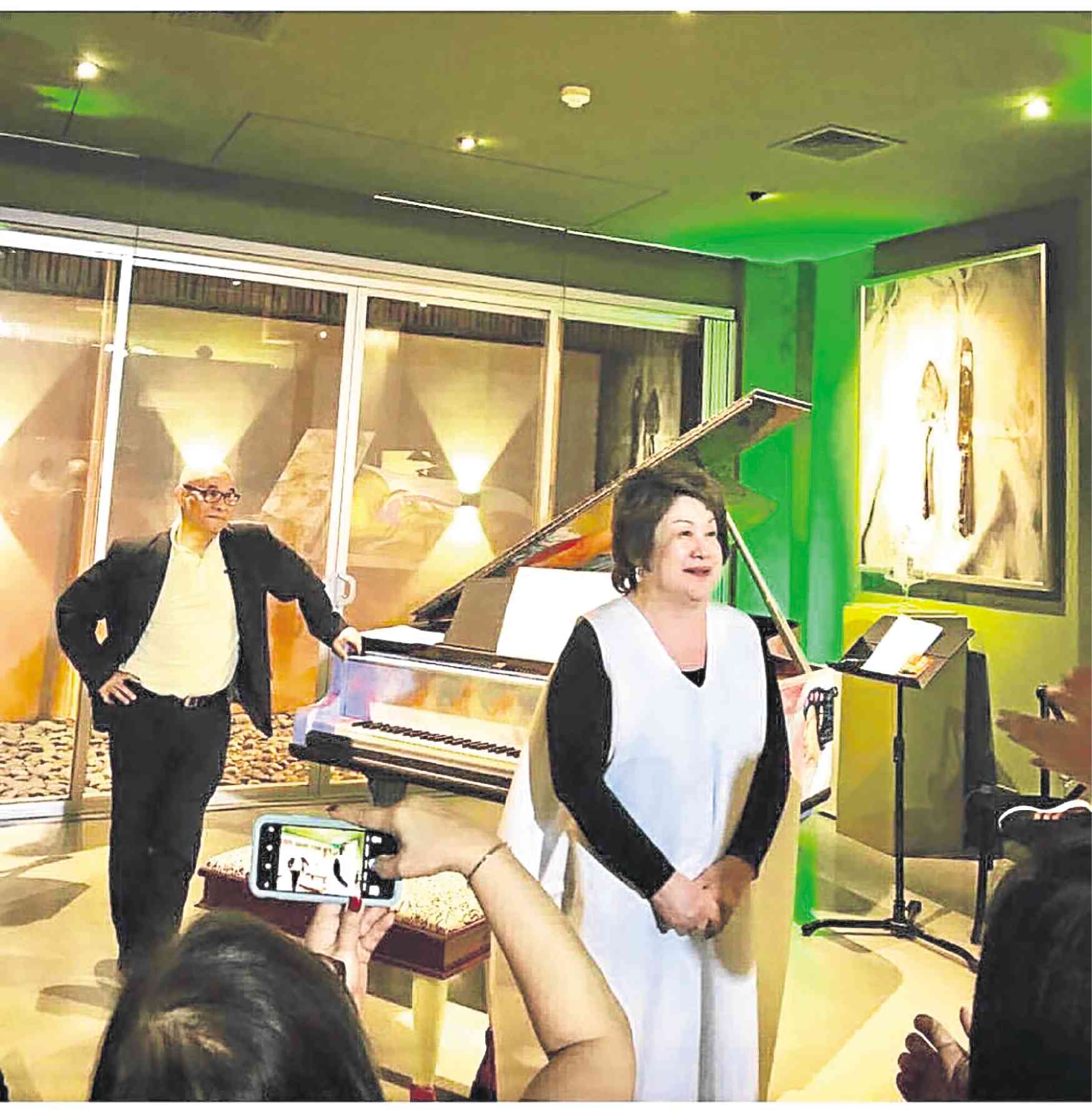
When you’ve been given a “good behavior pass” by your doctor, for following her orders to avoid yet another relapse from mild pneumonitis, you step out of the house for the first time in a week with heart a-flutter at the prospect of a good dinner.
Turned out, good was an understatement. It was a rare dinner that blended my favorite Debussy and Gershwin with Borlongan art. The living room at the Swatch building, its industrial-gray walls redone to a brighter hue, has been expanded yet its bigger space seemed cozier with soft lighting. The guests, numbering less than 30, made themselves comfortable on the low sofas, enjoying the pass-around hors d’oeuvre.
We sought out what we came for—the St. Cecilia grand piano that Elmer Borlongan and Plet Bolipata painted, the collaborative art that was to yield the music and visual stimulus that night. On Instagram, we had followed how the couple worked on the piano from day to day—such fun in the frenzy—until the image of St. Cecilia herself was taking shape.
And now it occupied a special place in the Swatch living room of Virgie Ramos, who has been an avid art collector for decades now. (I was surprised to see a portrait of her and her sons done by Veronica Yuyitung in the ’70s before the Yuyitungs went on exile in Canada. A rare portrait, indeed.)

Of the husband-and-wife collaboration, Plet wrote in the invite to this evening of unveiling of the St. Cecilia grand piano: “… We worked to the creative hum of our marriage—different styles, different heartbeats, different strengths, different visions—in perfect harmony.”
Before one could ponder—with envy—the making of such a marriage, scenographer Gino Gonzales introduced Jed Bolipata, the elder of the musical Bolipata brothers (the other two are Chino and Coke, who has steadily built the youth orchestra rooted in the family’s native Zambales and which plays at Malacañang state functions, set to be off on a foreign tour).
Jed, the piano prodigy of the ’80s, a graduate of The Juilliard School and a recipient of various awards, has been based in New York. He is a writer, a composer, filmmaker, photographer and is a top real estate broker in Manhattan. Here on a visit to celebrate their mom’s birthday, Plet’s kuya opens next weekend a photography exhibit at Boston Gallery.

‘Clair de Lune’
Jed opened the evening program with Beethoven’s “Moonlight Sonata” (First Movement), then on to Debussy’s “Clair de Lune,” always my sundown fare (writing to it has become a habit). Jed’s Debussy was so soothing yet stirring, and to a patient-on-the-loose like me, therapeutic.
Finally Jed went to everyone’s favorite, Gershwin’s “Rhapsody in Blue.” The guests rose from their seats when it was over to give him a rousing applause.
But the program wasn’t over. Gino introduced the Joanna Ampil, who sang “Love of My Life.” Joanna’s soaring and sinuous voice made us love Queen all the more, as we stole glances at Dr. Vicki Belo and Dr. Hayden Kho, and at another love-of-my-life-type of couple, the National Artist BenCab and Annie Sarthou.
By the time Joanna was into her last notes, Virgie had to dab away the tears. The St. Cecilia grand piano had been unveiled.
There was St. Cecilia with her lyre, seeming so serene on the piano lid, and underneath it, she was nude. Elmer and Plet’s St. Cecilia must have been like their marriage: a contrast of stark realism and whimsy, the sublime and the conventional. The St. Cecilia piano combined pain (she died a martyr) and fun (the legs of the piano seat wore boots). Just like any marriage.
Our curiosity about how Elmer (“Emong” to the art community) and Plet collaborated had been aroused appropriately. How could destiny have been so kind to an artist and his and her art? How could marriage between two passionate artists work?
Married for 21 years now, they met when Plet was asked by her brother Coke to pick up Emong in his house in Mandaluyong, because Coke had invited Emong to give an art talk in the Bolipatas’ Casa San Miguel in Zambales. Plet recounted the story to our friend, Sandy Tan-Uy.

Plet, who had been based in New York, had no idea who Emong was. On the bus on the way to Zambales, Plet showed him her works. When Emong’s turn to show his portfolio came, Plet was surprised to see that Emong was the artist whose painting, which she’d seen two years earlier, she was so impressed with. She really wanted to meet the artist.
Engaging
Their narrative is as engaging as their art.
At the prodding of Ms Ramos, Plet the storyteller recounts for us the couple’s journey that is St. Cecilia. (She has posted this on FB.) When the grand piano was delivered to Ms Ramos, after four months of collaboration and almost two years since the idea was broached, it came with a card from Plet and Emong. The card was a dedication—“a piece of us.”
Excerpts from Plet’s account:
“It was in the December 2017 Christmas party in Tita Virgie’s Greenhills home. Gino Gonzales takes us aside, shows us a Yamaha grand piano and asks if Emong and I would be interested to collaborate. Emong and I give each other that thrilled and challenged look, but gently tell him we have other commitments… Maybe someday in the future…
“The future came too soon.
“October 2018: In between trips to Hong Kong to print Emong’s two-volume books of his paintings and drawings to be launched in May 2019, we pick up our brushes.
“It begins with Emong asking me if painting an image of St. Cecilia is a good idea. Emong remembers a poster of St. Cecilia on top of their upright piano in his grandparents’ home in Mandaluyong. I agree. The idea is always the first step. That the idea is borne from a childhood memory bathes it in complexity. It has stirrings of youth and memory. Emong is quick to start his studies and work on his maquette of illustration and foam boards.
“I decide to research and Google her life story. My friends from high school recently visited her tomb in Italy, so they fed me information from their tour guide.
Unperturbed
“I was inspired by her brave story. I ask myself if I would have had the same courage to defend my faith and perhaps be unperturbed when thrown into a den of lions, or burned, or beheaded. Probably not. Well, here was St. Cecilia, who was all that and more. She is one of the most famous Roman martyrs and is the patroness of music. Me being a Bolipata and raised in a musical family, this utterly stirred my soul.
“This is what we wanted to depict:
“1. She came from a well-to-do family, so her clothes were rich in fabric. But she was dedicated to God and a life of simplicity, so she wore close to a sack dress underneath her fine clothes. You see her wearing a plain sackcloth underneath the finery in our rendition of St. Cecilia holding a lyre.
“2. Roses and lilies are flowers attributed to her.
“3. Virginity and Martyrdom:
From my Google: ‘She vowed her virginity to Christ, but her parents married her off anyway. The story of how she converted her husband is quite remarkable. During the wedding, Cecilia sat apart singing to God in her heart… On her wedding night she made her vow known to him, and informed him that an angel guarded her purity. Her husband replied that he would believe her and honor her vow if he could also see her angel. Cecilia instructed him to first be baptized. Following his baptism, Valerian returned to his wife and found an angel at her side. The angel then crowned Cecilia with a chaplet of rose and lily and when Valerian’s brother, Tibertius, heard of the angel and his brother’s baptism, he also was baptized, and together the brothers dedicated their lives to burying the saints who were murdered each day. Both brothers were eventually arrested and brought before the prefect where they were executed after they refused to offer a sacrifice to the gods.
Strength of faith
‘St. Cecilia responded by burying her husband and converting hundreds of people through her Christian witness and strength of faith. This, and her refusal to worship false gods, resulted in her being arrested.
‘According to legend, St. Cecilia was not martyred easily. They first attempted to suffocate her, but it did not affect her. Then they attempted to behead her, but they were again unsuccessful even after three blows to the neck. She instead bled to death for three days as she continued to preach, and fellow Christians collected her blood in sponges and napkins as relics.’
“I requested Emong that this was the part I wanted to thresh out underneath the lid of the piano. I haven’t painted in oils in years. I was eager to flex my painting muscles and to portray her in the nude (most of my works are female nudes and their issues), holding on to a rosary, desperate on the shore of a deserted beach, close to death, with sword slashes on her neck. When I showed it to my siblings, Coke quickly gave a title, ‘Despair at the shores of her youth.’
“I wanted a crow there because I read somewhere that crows are known to make out even with dead crows. I thought that was an interesting ‘sexual’ angle. Emong gave me all the freedom to execute this idea, and allowed me to paint the nude and the blue sea. All the other elements of this scene, he took over.
“Emong was more emphatic about her virginity. He would paint vines with thorns on the piano legs. It’s like you could never get to touch her.
“The body of the piano are clouds I painted surrounding Emong’s two female angels singing. I thought painting their hair blue would give them a bit of my personality.
“Emong wanted to paint different hands on the lid of the piano. Hands of different classical and jazz musicians. Since he wanted to go in that direction, I decided to leave the resin red boots (inspired by my Little Red Riding Hood in New York) of the piano bench. We thought these two ideas, though disparate, blended seamlessly.
“The fabric of the piano bench is designed by the British painter, Duncan Grant of the Bloomsbury Group. I am a huge fan of the group that included the talented sisters, writer Virginia Woolf and painter Vanessa Bell, among others, and were of different sexual persuasions. I went all the way to their home in the UK in 2017 with my cousin and niece. The Bloomsbury group, a tight-knit community of free thinkers and homebodies, lived harmoniously in deep friendship, and loved in triangles. Loyalty to each other was their code of ethics. They tended their garden with great care and artistry. I went home with a piece of fabric.
Everyday objects
“When I took Emong there in 2018, he was attracted to the way they extended their art practice to everyday objects—doors, tables, lamps, and church decoration.
“The grand piano was more than what we bargained for, for an object. Emong and I, now with a grand piano, have the opportunity to extend our visual practice to an object and push our boundaries. What was just a dream in the UK countryside, following in Bloomsbury’s artistic footsteps, was now our reality.
“Painting this piano, I would pray to St. Cecilia, quietly and dutifully, and ask her for divine provenance, bodily strength and peace of mind to finish the work. Emong’s father took ill and was hospitalized for a couple of weeks, so we turned to her to intercede for his swift recovery. Our prayers worked miracles.
“Last week of January 2019: delivery.
“It was imperative to finish the work because bringing it to our studio in the mango farm in Zambales was not an option. Termites would easily finish it up. So we worked like madmen.
“We cried a little when men from Lyric took the piano, our baby, from us that cool January morning. The house was empty; it was the last big piece to leave our rented home. We felt like a big chunk of our life here was wrapped up in the body of the piano, and taken away. We were left with the tiny pieces to pack and prepare for the big move back to our quiet life on the farm.
“The icing on the cake arrived when pictures were sent us after delivery. We worked on the piano separately. We had Lyric remove the lid and worked on both sides of it in Emong’s studio on the second floor of our rented home. The body, we painted in our living room.
“So imagine our happiness when the lid was attached and both parts blended perfectly with each other as it stood monstrous and proud in Tita Virgie’s living room. Such divine serendipity! And that was when Emong and I exchanged our high fives!
“Working together (this is only our second major collaboration), we had artistic compromises. Emong and I learned early in our marriage how to respect each other and work around our strengths and weaknesses as creative partners. In our studio, we are equals. We gave it our all. We poured our hearts and souls into this grand piano. Emong gave it the consistency and mastery with his deft hand at painting and drawing.
“I’d like to think I gave it the narrative and color that completed her saintly story. From beginning to end, we worked to the creative hum of our marriage—different styles, different heartbeats, different strengths, different visions—in perfect harmony. ”
March 14, 2019
San Antonio, Zambales








































